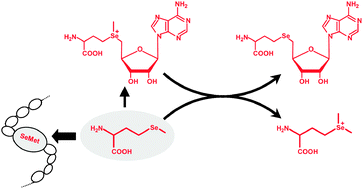Speciation of selenomethionine metabolites in wheat germ extract†
Abstract
Selenometabolites transformed from

Maintenance work is planned for Wednesday 1st May 2024 from 9:00am to 11:00am (BST).
During this time, the performance of our website may be affected - searches may run slowly and some pages may be temporarily unavailable. If this happens, please try refreshing your web browser or try waiting two to three minutes before trying again.
We apologise for any inconvenience this might cause and thank you for your patience.
* Corresponding authors
a
Graduate School of Pharmaceutical Sciences, Chiba University, Inohana, Chuo, Chiba 260-8675, Japan
E-mail:
ogra@p.chiba-u.ac.jp
Fax: +81 43 226 2866
Tel: +81 43 226 2866
Selenometabolites transformed from

 Please wait while we load your content...
Something went wrong. Try again?
Please wait while we load your content...
Something went wrong. Try again?
 Fetching data from CrossRef.
Fetching data from CrossRef.
This may take some time to load.
Loading related content
